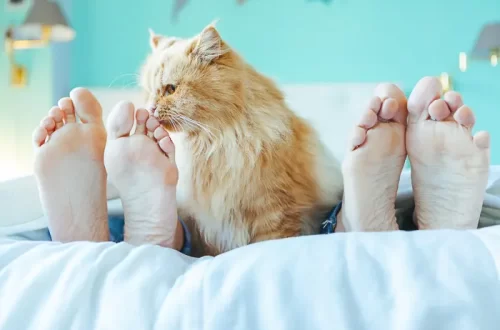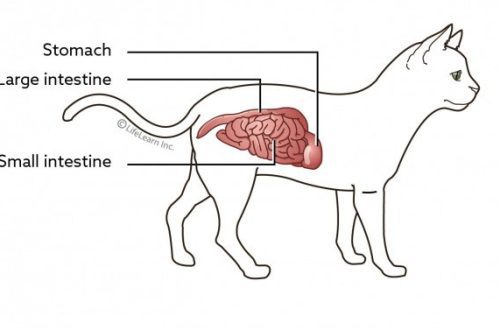
Conjunctivitis in cats

So what is conjunctivitis? In general, when the name of a disease ends with “-itis”, it means that it has an inflammatory cause.
For example:
Gastritis – inflammation of the stomach;
Dermatitis – inflammation of the skin;
Conjunctivitis is an inflammation of the mucous membrane of the eye.

Photo of conjunctivitis in cats
Contents
Types of disease
Depending on the nature of the liquid separated from the eye, there are:
Catarrhal – the owner notices that tears are flowing from the eye, transparent mucus. Very often, such conjunctivitis can later turn into the following form.
Purulent conjunctivitis – pus comes out of the eye. It can be white, yellow, greenish, more or less thick. Often the eyelids are glued together with discharge, a “path” to the nose is expressed. The hair around the eye can be sparse, the cat can scratch its muzzle hard, trying to get rid of the thick pus that covers the eye, and tear out shreds of hair.
Depending on the characteristics of the process, there are:
Chronic – usually this is a long-term process, the severity of symptoms can change, the duration is measured in months or years, it can be lifelong;
Subacute – several weeks or days, often accompanied by respiratory infections;
Acute – several hours, typical for injuries.

Causes of Conjunctivitis in Cats
infectious
The most common cause of conjunctivitis in a cat is an infection (viral, bacterial, fungal, chlamydial). This disease mainly appears after contact with other cats; Infectious conjunctivitis is more likely to occur in kittens than in adult animals, because they are more prone to infections.
The most common infections that cause “eye” symptoms are chlamydia, mycoplasmosis, and feline herpes virus (FHV-1).
Physical impact
Inflammation of the conjunctiva caused by trauma and foreign bodies in the eye is more common in adults walking outdoors. Exposure to extremely high or low temperatures can also lead to conjunctivitis.
Chemical exposure
Chemicals (vapours of chlorine-containing compounds, kerosene, etc.) can cause conjunctival burns and, as a result, inflammation.
Systemic diseases
General therapeutic and autoimmune diseases, dry keratoconjunctivitis are diseases in which problems arise not under the influence of external factors, but through the fault of the body itself.

Symptoms
What does the owner of a cat with conjunctivitis notice?
The visible tissues of the eye of such a cat are enlarged (edema), reddened (hyperemia), there is a path towards the nose (exudation).
It is a mistake to assume that the cause of the symptoms can be immediately determined by the appearance and quality of the discharge from the eye or from the photo, because in the eye there are normally a lot of microorganisms with which local immunity constantly interacts, and if a cat has any pathology, their active growth begins , and this process can confuse the clinical picture (not every purulent conjunctivitis is infectious, for example).
Treatment of Conjunctivitis in Cats
Conjunctivitis in cats should only be treated by a veterinarian. Almost always, a photo or a personal examination is not enough to prescribe the right treatment, and the doctor will treat conjunctivitis in cats only after a set of diagnostic measures: a general examination, ophthalmoscopy, a fluorescein test, and swabs for infections.
Conjunctivitis in cats can be treated with topical treatments. These can be eye drops, ointments, gels containing antibiotics, bacteriostatics, non-steroidal anti-inflammatory drugs, hormones, as well as agents that increase regenerative functions.
It is important to observe the frequency and frequency of application of local preparations: for example, many drops must be used once every 1 hours, otherwise they will be ineffective, since the tear constantly washes the eye and because of this the medicine does not stay there for long. Some drugs must be applied strictly in a certain sequence. All manipulations with the eye are performed after its hygienic treatment. If the ophthalmologist has not recommended otherwise, then the eyes are washed with saline (2% sodium chloride solution) using a richly moistened cotton pad, from the outer corner of the eye to the inner. A new cotton pad should be used for each eye.
For the treatment of conjunctivitis, which are symptoms of a systemic disease (eg, allergic, chlamydial, FHV-1 associated), injections or tablets are often used.
Often, in order to obtain an optimal result, complex therapy is prescribed, consisting of treatment with systemic and local drugs at the same time.

conjunctivitis in kittens
It is necessary to treat conjunctivitis in kittens especially carefully, and here’s why: it is kittens up to a year that are much more likely than cats of other age groups to suffer from respiratory infections, and conjunctivitis is one of the primary symptoms of such diseases. Rhinotracheitis, calicivirus, chlamydia and mycoplasmosis are often manifested by lacrimation and photophobia (the cat squints its eyes), and later purulent exudate joins.
Prevention
Measures to prevent any disease are directly related to understanding the cause of the disease.
So for conjunctivitis it is:
Strict observance of zootechnical standards of maintenance. Lack of crowding of animals, quarantine of new arrivals (nurseries, overexposure), good nutrition, fresh air (in no case should you keep a cat in a smoky room, because this will certainly lead to the need to treat allergies and, accordingly, conjunctivitis).
Timely vaccination of animals. Effective vaccines exist for calicivirus and rhinotracheitis, and chlamydia immunoprophylaxis is also available.
Secure the containment environment. Remove cacti, chemicals from access; do not allow cats to walk on their own, do not keep conflicting animals in the common area.

Conjunctivitis in Cats: Essentials
Conjunctivitis is by far the most common inflammatory eye disease in cats. Inflammation is a protective reaction of any organ and tissue to injury, the introduction of an infection or a foreign object. Thus, the symptoms of conjunctivitis are a wake-up call for the owner to pay attention to go to the veterinarian. It is important to remember that conjunctivitis can be not only a local problem, but also be a companion of a serious systemic pathology.
If you notice redness and / or swelling of eye tissues, a lacrimal duct in your cat, then you need to make an appointment with a veterinary clinic as soon as possible. If for some reason an urgent visit is impossible, then in no case do not use “human” eye drops – they can seriously harm!
As part of the first aid, flush the eye with saline sodium chloride solution as above, keep the cat away from bright lights, put on a protective collar on the cat if it scratches its eyes (to prevent self-injury).
Pay special attention to the treatment of conjunctivitis in kittens. Stay calm, act thoughtfully and methodically, and everything will definitely be fine!
The article is not a call to action!
For a more detailed study of the problem, we recommend contacting a specialist.
Ask the vet
October 21 2020
Updated: 21 May 2022





